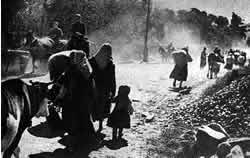Armeno-Turkish War, 1920
Enlarge text Shrink text- Work cat.: 2003546504: Artsruni, Vahē. Hay-tachkakan paterazmě, 2002.
- Lebanese Youth Association of the Armenian Revolutionary Federation WWW site, Sept. 22, 2003
The Turkish–Armenian War (Armenian: Հայ-թուրքական պատերազմ), known in Turkey as the Eastern Front (Turkish: Doğu Cephesi) of the Turkish War of Independence, was a conflict between the First Republic of Armenia and the Turkish National Movement following the collapse of the Treaty of Sèvres in 1920. After the provisional government of Ahmet Tevfik Pasha failed to win support for ratification of the treaty, remnants of the Ottoman Army's XV Corps under the command of Kâzım Karabekir attacked Armenian forces controlling the area surrounding Kars, eventually recapturing most of the territory in the South Caucasus that had been part of the Ottoman Empire prior to the Russo-Turkish War (1877–1878) and was subsequently ceded by Soviet Russia as part of the Treaty of Brest-Litovsk. Karabekir had orders from the Ankara Government to "eliminate Armenia physically and politically". One estimate places the number of Armenians massacred by the Turkish army during the war at 100,000—this is evident in the marked decline (−25.1%) of the population of modern-day Armenia from 961,677 in 1919 to 720,000 in 1920. According to historian Raymond Kévorkian, only the Soviet occupation of Armenia prevented another Armenian genocide. The Turkish military victory was followed by the Bolshevik occupation of Armenia and the establishment of the Armenian Soviet Socialist Republic. The Treaty of Moscow (March 1921) between Soviet Russia and the Grand National Assembly of Turkey and the related Treaty of Kars (October 1921) confirmed most of the territorial gains made by Karabekir and established the modern Turkish–Armenian border.
Read more on Wikipedia >
 Topic
Topic






